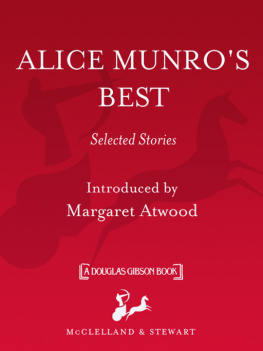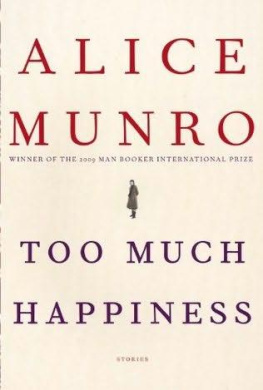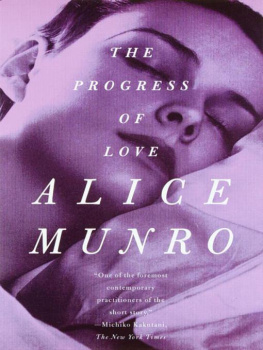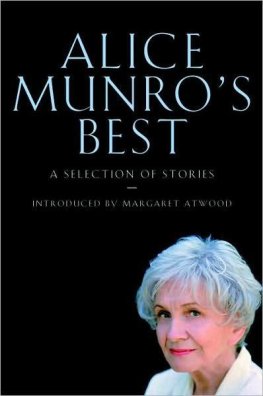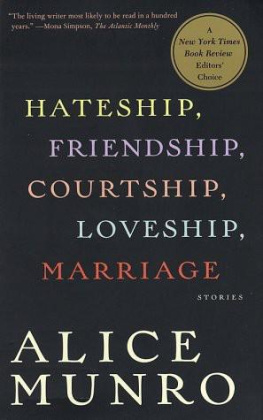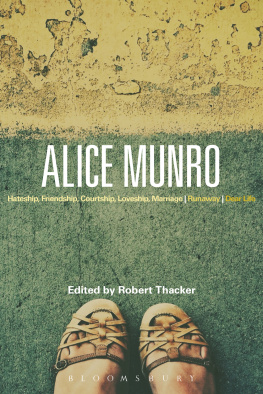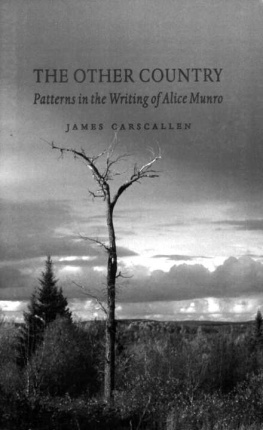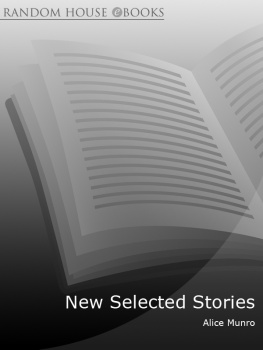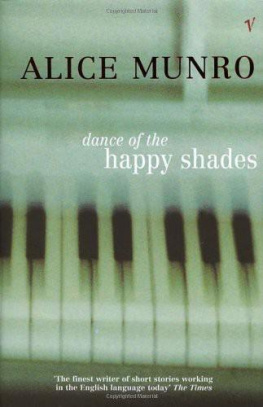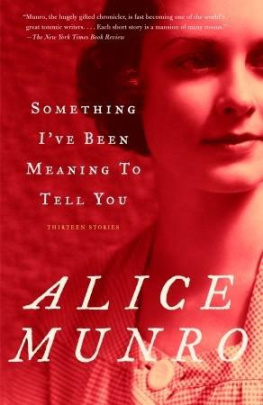Alice Munro - Friend of My Youth: Stories
Here you can read online Alice Munro - Friend of My Youth: Stories full text of the book (entire story) in english for free. Download pdf and epub, get meaning, cover and reviews about this ebook. year: 1991, publisher: Vintage, genre: Art. Description of the work, (preface) as well as reviews are available. Best literature library LitArk.com created for fans of good reading and offers a wide selection of genres:
Romance novel
Science fiction
Adventure
Detective
Science
History
Home and family
Prose
Art
Politics
Computer
Non-fiction
Religion
Business
Children
Humor
Choose a favorite category and find really read worthwhile books. Enjoy immersion in the world of imagination, feel the emotions of the characters or learn something new for yourself, make an fascinating discovery.

- Book:Friend of My Youth: Stories
- Author:
- Publisher:Vintage
- Genre:
- Year:1991
- Rating:5 / 5
- Favourites:Add to favourites
- Your mark:
- 100
- 1
- 2
- 3
- 4
- 5
Friend of My Youth: Stories: summary, description and annotation
We offer to read an annotation, description, summary or preface (depends on what the author of the book "Friend of My Youth: Stories" wrote himself). If you haven't found the necessary information about the book — write in the comments, we will try to find it.
[Friend of My Youth is] a wonderful collection of stories, beautifully written and deeply felt.--Michiko Kakutani, New York Times
Friend of My Youth: Stories — read online for free the complete book (whole text) full work
Below is the text of the book, divided by pages. System saving the place of the last page read, allows you to conveniently read the book "Friend of My Youth: Stories" online for free, without having to search again every time where you left off. Put a bookmark, and you can go to the page where you finished reading at any time.
Font size:
Interval:
Bookmark:
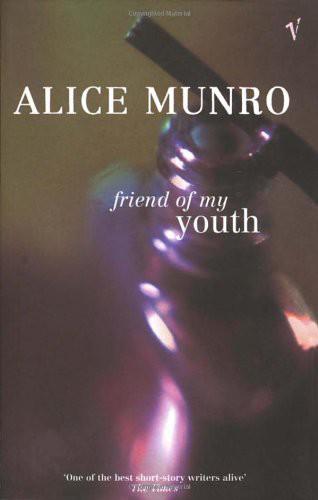
Friend of My Youth
Munro, the hugely gifted chronicler is fast becominglike Raymond Carverone of the worlds great totemic writers, able to excite recognition even in readers who grew up in times and societies very different from hers. Each short story is a mansion of many rooms.
Bharati Mukherjee, The New York Times Book Review
Each of her collections demonstrates such linguistic skill, delicacy of vision, and moral strength and clarity that the notion of her pre-eminence becomes ever more irresistible.
Chicago Tribune
Munros stories possess almost all the things a reader might desireanecdotes, shining everyday details, sexual passion, family history, quirky characters, new landscapes, humor, wisdom.
Philadelphia Inquirer
Munro is a fine writer, an excellent writer, a gifted craftsman, an inspired strategist of plot and emotional counterpoint. She is one of the three or four best writers of short stories in English today.
St. Petersburg Times
Munro is wickedly funny and she is a consummate stylist. Her sentences, though never gaudy, are always perfectly cadenced, and almost epigrammatically beautiful. Munro is that rarity, an author unafraid to write about people as intelligent as she is.
Newsweek
Brilliant [Munro is] an unrivalled chronicler of human nature.
The Sunday Times (London)
ALSO BY ALICE MUNRO
The View from Castle Rock
Carried Away
Runaway
Hateship, Friendship, Courtship, Loveship, Marriage
The Love of a Good Woman
Selected Stories
Open Secrets
Friend of My Youth
The Progress of Love
The Moons of Jupiter
The Beggar Maid
Something Ive Been Meaning to Tell You
Lives of Girls and Women
Dance of the Happy Shades
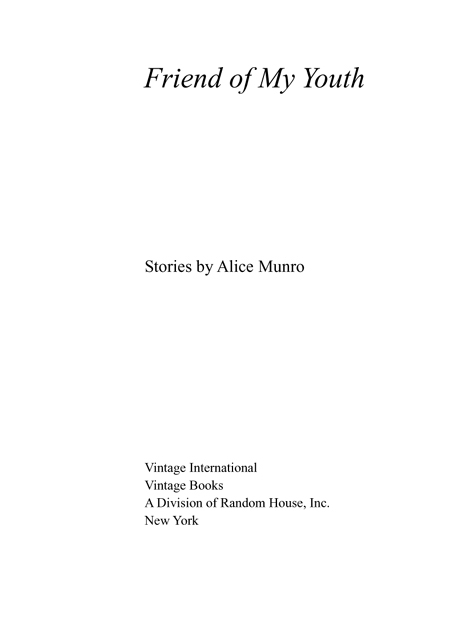
FIRST VINTAGE INTERNATIONAL EDITION, MAY 1991
Copyright 1990 by Alice Munro
All rights reserved under International and Pan-American Copyright Conventions. Published in the United States by Vintage Books, a division of Random House, Inc., New York. Originally published in hardcover by Alfred A. Knopf, Inc., New York, in 1990.
Vintage is a registered trademark and Vintage International and colophon are trademarks of Random House, Inc.
The stories in this work were originally published in the following:
The Atlantic: Hold Me Fast, Dont Let Me Pass, Pictures of the Ice.
The New Yorker: Friend of My Youth, Meneseteung, Oh, What Avails, Oranges and Apples, Goodness and Mercy, Differently, Five Points, Wigtime.
eISBN: 978-0-307-81459-3
www.vintagebooks.com
v3.1
To the memory of my mother


WITH THANKS TO R. J. T .
I used to dream about my mother, and though the details in the dream varied, the surprise in it was always the same. The dream stopped, I suppose because it was too transparent in its hopefulness, too easy in its forgiveness.
In the dream I would be the age I really was, living the life I was really living, and I would discover that my mother was still alive. (The fact is, she died when I was in my early twenties and she in her early fifties.) Sometimes I would find myself in our old kitchen, where my mother would be rolling out piecrust on the table, or washing the dishes in the battered cream-colored dishpan with the red rim. But other times I would run into her on the street, in places where I would never have expected to see her. She might be walking through a handsome hotel lobby, or lining up in an airport. She would be looking quite wellnot exactly youthful, not entirely untouched by the paralyzing disease that held her in its grip for a decade or more before her death, but so much better than I remembered that I would be astonished. Oh, I just have this little tremor in my arm, she would say, and a little stiffness up this side of my face. It is a nuisance but I get around.
I recovered then what in waking life I had lostmy mothers liveliness of face and voice before her throat muscles stiffened and a woeful, impersonal mask fastened itself over her features. How could I have forgotten this, I would think in the dreamthe casual humor she had, not ironic but merry, the lightness and impatience and confidence? I would say that I was sorry I hadnt been to see her in such a long timemeaning not that I felt guilty but that I was sorry I had kept a bugbear in my mind, instead of this realityand the strangest, kindest thing of all to me was her matter-of-fact reply.
Oh, well, she said, better late than never. I was sure Id see you someday.
When my mother was a young woman with a soft, mischievous face and shiny, opaque silk stockings on her plump legs (I have seen a photograph of her, with her pupils), she went to teach at a one-room school, called Grieves School, in the Ottawa Valley. The school was on a corner of the farm that belonged to the Grieves familya very good farm for that country. Well-drained fields with none of the Precambrian rock shouldering through the soil, a little willow-edged river running alongside, a sugar bush, log barns, and a large, unornamented house whose wooden walls had never been painted but had been left to weather. And when wood weathers in the Ottawa Valley, my mother said, I do not know why this is, but it never turns gray, it turns black. There must be something in the air, she said. She often spoke of the Ottawa Valley, which was her homeshe had grown up about twenty miles away from Grieves Schoolin a dogmatic, mystified way, emphasizing things about it that distinguished it from any other place on earth. Houses turn black, maple syrup has a taste no maple syrup produced elsewhere can equal, bears amble within sight of farmhouses. Of course I was disappointed when I finally got to see this place. It was not a valley at all, if by that you mean a cleft between hills; it was a mixture of flat fields and low rocks and heavy bush and little lakesa scrambled, disarranged sort of country with no easy harmony about it, not yielding readily to any description.
The log barns and unpainted house, common enough on poor farms, were not in the Grieveses case a sign of poverty but of policy. They had the money but they did not spend it. That was what people told my mother. The Grieveses worked hard and they were far from ignorant, but they were very backward. They didnt have a car or electricity or a telephone or a tractor. Some people thought this was because they were Cameroniansthey were the only people in the school district who were of that religionbut in fact their church (which they themselves always called the Reformed Presbyterian) did not forbid engines or electricity or any inventions of that sort, just card playing, dancing, movies, and, on Sundays, any activity at all that was not religious or unavoidable.
My mother could not say who the Cameronians were or why they were called that. Some freak religion from Scotland, she said from the perch of her obedient and lighthearted Anglicanism. The teacher always boarded with the Grieveses, and my mother was a little daunted at the thought of going to live in that black board house with its paralytic Sundays and coal-oil lamps and primitive notions. But she was engaged by that time, she wanted to work on her trousseau instead of running around the country having a good time, and she figured she could get home one Sunday out of three. (On Sundays at the Grieveses house, you could light a fire for heat but not for cooking, you could not even boil the kettle to make tea, and you were not supposed to write a letter or swat a fly. But it turned out that my mother was exempt from these rules. No, no, said Flora Grieves, laughing at her. That doesnt mean you. You must just go on as youre used to doing. And after a while my mother had made friends with Flora to such an extent that she wasnt even going home on the Sundays when shed planned to.)
Font size:
Interval:
Bookmark:
Similar books «Friend of My Youth: Stories»
Look at similar books to Friend of My Youth: Stories. We have selected literature similar in name and meaning in the hope of providing readers with more options to find new, interesting, not yet read works.
Discussion, reviews of the book Friend of My Youth: Stories and just readers' own opinions. Leave your comments, write what you think about the work, its meaning or the main characters. Specify what exactly you liked and what you didn't like, and why you think so.

